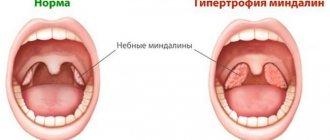Patient complaints are not so specific. Ingoda the patient comes to the otolaryngologist and cannot clearly formulate what is happening in his throat. Either it hurts or it doesn’t. Someone runs to the doctor and shouts: “I have a sore throat, I urgently need help.” Indeed, having seen certain redness in the throat, some patients evaluate this condition only as a sore throat.
Of course, pain and redness in the throat occur with various pathologies, and it is not always possible to distinguish a healthy throat from a diseased one by self-assessment.
What should a healthy throat look like?
Probably, most otolaryngologists will say: “I can only show the differences between a healthy and a sore throat in a photo or picture, because Nowadays, the impeccable condition of the oropharynx is a rarity.”
Most schoolchildren, despite their young age, have chronic signs of oropharyngeal diseases. Such pathologies include: tonsillitis, sore throat, pharyngitis, nasopharyngitis.
If inflammatory diseases of the throat are not treated, you can get not only local complications, but also become a victim of rheumatism, kidney and heart diseases. Moreover, an untreated acute infection in the throat often leads to surgical treatment, not to mention the fact that, for example, chronic pharyngitis remains a problem for life.
It should be noted that self-diagnosis is necessary. A patient with minimal knowledge of what a healthy throat should look like can already determine whether he has problems and whether he needs to see a doctor.
The textbooks on otolaryngology clearly highlight the signs of throat diseases, which can be used to determine whether everything is in order in the oropharynx. Among them are the following descriptions that define a healthy throat:
- the posterior wall of the pharynx has a smooth surface, there are no hypertrophied follicles, the network of vessels is not dilated, no other pathologies are observed,
- there is no visible swelling on the entire surface of the throat and nearby tissues,
- there is no hyperemia in all its manifestations: the throat has a color from pale pink to pinkish tones without spots. All parts of the throat practically merge into one color,
- tonsils are small in size, not swollen, and do not contain various inclusions or plaque. Small tubercles may be present; sharp transitions and elevations in the tonsil area are not observed.
The functions of the tonsils and their appearance are normal
Before diagnosing throat diseases, it is necessary to familiarize yourself with general information about the functions and appearance of the tonsils. These formations are accumulations of lymphoid tissue and are often called tonsils.
- Red throat in a child: how to treat it at home if it constantly hurts and hurts to swallow?
Tonsils perform two main functions: protective and hematopoietic. They produce antibodies that fight pathogenic microorganisms, preventing them from entering the body. The tonsils also form lymphocytes - cells of the immune system.
A healthy person has 4 tonsils: 2 paired and 2 unpaired, they are located at the junction of the nasopharynx and pharynx. Normally, these formations are the size of a walnut and are colored light pink. Also signs of normal tonsils include:
- absence of redness and plaque;
- the mucous membrane is not inflamed, there is no pronounced vascular pattern;
- the tonsils do not come into contact with the palatine arches and do not extend beyond them;
- When pressing on the tonsils with a medical spatula, no pus or mucus is released.
The combination of all these signs indicates a person’s health. However, for some people, increased size of the tonsils is the norm - this is an individual characteristic of the body.
Healthy throat: differences from pathology
When examining a healthy throat, all the signs that we indicated above should be present, regardless of the patient’s age.
In most cases, a “beautiful throat” is rare. Some people have slight granularity, indicating pharyngitis, others have minor pathologies of the tonsils. And this is not to mention the obvious changes in the oropharynx.
When performing the diagnosis yourself, you should be alert to the following signs indicating a pathological process:
- mucus drips down the back of the throat. There may be several reasons for this condition: rhinitis, sinusitis, thinning of the pharyngeal mucosa, adenoiditis (more common in pediatric practice). Some patients refer to the mucus that drains as phlegm. It is not right. Sputum is secreted from the lower parts of the respiratory system and can appear in the mouth only when coughing (bronchitis, tuberculosis and other diseases),
- the appearance of redness of varying degrees of intensity, including individual spotting and granulation. The soft palate is often inflamed. The bright red walls of the pharynx stand out especially. This condition of the throat is accompanied by soreness, soreness, and itching. In principle, the presented picture indicates acute pharyngitis, starting with ARVI,
- The back wall of the throat is dotted with enlarged follicles, i.e. the pharynx has a loose surface. However, the throat does not have to be red. In most cases, this picture is observed in chronic forms of pharyngitis,
- uneven surface of the pharyngeal mucosa, all kinds of ulcers, blisters similar to herpetic rashes (possibly herpetic sore throat),
- inflamed and hyperemic tonsils, as if engorged with blood,
- the back wall of the pharynx seems thin, blood vessels appear on it, it is pale, as if covered with varnish. The presented description indicates atrophic pharyngitis,
Forms of pharyngitis
According to its clinical course, pharyngitis can be chronic and acute.
The chronic form is divided into:
- hypertrophic – this is an increase in mucous membrane;
- atrophic – this is the depletion of the mucous membrane;
- catarrhal – standard inflammation.
The acute form also exists in three types:
- allergic – provoked by allergens;
- infectious – caused by pathogenic microorganisms;
- post-traumatic – occurs due to contact with the mucous membrane of irritating substances.
Throat examination
Unfortunately, it is not always possible to examine the throats of loved ones objectively.
For example, while looking down the child’s throat, a mother suddenly sees something “suspicious” and in a panic drags the baby to the pediatrician.
Of course, many people lack medical knowledge, but parents who have two or more children in the family are more likely to gain experience.
And yet, you need to be able to determine whether your throat is healthy or sore, i.e. not to make a diagnosis, but to understand whether the oropharynx is normal or pathological.
To assess the condition of the throat, it is necessary to conduct an examination:
- bring the patient closer to daylight, it is better to find a place near a window, or sit him on a chair and take a flashlight with a bright light bulb. We ask the patient to open his mouth wider and press his tongue so that the entire lumen of the throat is visible. If this maneuver does not work for the patient, it is necessary to use a spatula or a teaspoon to press the tongue. Next, we illuminate the pharynx well and examine all parts of the throat,
- You need to press on the spatula carefully, because... Some patients experience a gag reflex, so the examination procedure must be performed quickly. Do not press the spatula on the root of the tongue; it is enough to press the tongue in its middle part,
- when examining the tonsils, when we need to assess whether there is tonsillitis or tonsillitis, it is enough to stick your tongue forward; there is no need to press it. Using a flashlight, we examine the tonsils for plugs and purulent contents,
- During the examination, the patient must breathe deeply and evenly, this makes it possible to lower the tongue to the lower palate.
The degree of enlargement of the tonsils.
There are four stages of enlargement of the tonsils. At the first stage, the tonsils occupy a third of the space between the pharynx and the palate. In this case they are said to be slightly enlarged. Symptoms of the disease do not manifest themselves in any way.
At the second stage, the tonsils already occupy half of the free space. There is discomfort when swallowing liquids, food and breathing. Tissue hypertrophy is average.
In the third stage, swallowing becomes very difficult as the lymphoid tissue increases to an impressive size.
The fourth stage is characterized by severe hypertrophy, when the tonsils completely block the pharynx. This condition interferes with proper breathing and nutrition.
If inflammation of the tonsils begins, without timely treatment, the stages quickly replace each other.
Diagnostics
Whether the patient has a throat disease or not, only a specialist can answer this question. The first step to identifying all problems with the throat is a visit to the otolaryngologist's office, where a differential diagnosis will be carried out. If in doubt, the doctor will prescribe a further examination, which includes:
- survey (collecting anamnesis). The doctor questions the patient in detail, determining the main complaints and the duration of the disease, if any. The doctor is interested in literally everything, even stressful situations that can cause, for example, aphonia,
- performing rhinoscopy (standard examination). Upon examination, pathological processes in the nasopharynx are detected,
- endoscopic rhinoscopy – therapeutic and diagnostic manipulation (allows for minimally invasive surgical interventions),
- X-ray examination of the maxillary sinus and other sinuses. Thanks to x-rays, acute and chronic foci of infection are determined,
- general blood and urine analysis . Particular attention is paid to indicators such as ESR and leukocyte count. Their increase indicates an inflammatory process. If band neutrophils are also elevated in the analysis, we are talking about an acute infection,
- bacterial culture from the nasopharynx . The results of the study allow us to determine which infection causes inflammation in the throat. Staphylococci take the lead in sowing; they inseminate the nasopharynx and lead to various diseases of the nose and throat. In second place are streptococci, and they are not inferior in insidiousness. For example, streptococcal tonsillitis often causes complications in the heart (myocarditis) and joints.
Main factors that increase the risk of developing the disease
In addition to the reasons that increase the risk of developing pharyngitis, there are also certain risk factors:
- The presence in the air regularly appears of a lot of dust, other pollutants, including harmful chemicals, in or near industries, corrosive gases;
- Failure to comply with the temperature regime for food and drink, inhalation of very hot or cold air;
- Regular drinking of alcohol or smoking tobacco products of any kind;
- Constant overstrain of the vocal cords due to specific professions, for example, if a person sings or talks a lot;
- Removal of tonsils, which leads to an increase in harmful microorganisms in the throat;
- Breathing through the mouth due to difficulty passing air through the nasal passages.
If a person knows about any problem from the list of causes of pharyngitis, he should carefully avoid the mentioned risk factors - their combination greatly increases the likelihood of developing the disease.
Treating a sore throat if necessary
Treatment for throat diseases depends on the diagnosis. A viral throat (usually pharyngitis) does not require antibacterial drugs.
It is enough to rinse with medicinal herbs and antiseptics.
Inhalations with alkaline solutions give good results.
The patient is also recommended tablet antiviral therapy.
Herpetic sore throat, like pharyngitis, is treated with antiviral drugs; antibiotics can only aggravate this disease. The treatment regimen includes antipyretics, antihistamines, vitamins and immunomodulators.
For sore throat and tonsillitis, antibacterial treatment cannot be avoided, and it must be carried out in a timely manner. Purulent plaque spreads very quickly, therefore, complications from other organs cannot be allowed. Typically, the treatment process begins with penicillins; if they are ineffective, they resort to macrolides or cephalosporins.
Fungal infections of the throat are often observed after long-term antibiotic therapy. To get rid of candidiasis, antimycotic and antiseptic agents are used. Irrigation, rinsing, dissolving tablets and lubricating with solutions are prescribed. It is possible to quickly cure a fungal infection, provided that all the specialist’s instructions are strictly followed.
Important! It is strictly forbidden to carry out independent antibacterial treatment. Unfortunately, many citizens attribute antibiotics to themselves without any justification, explaining their actions in order to prevent complications at all costs.










